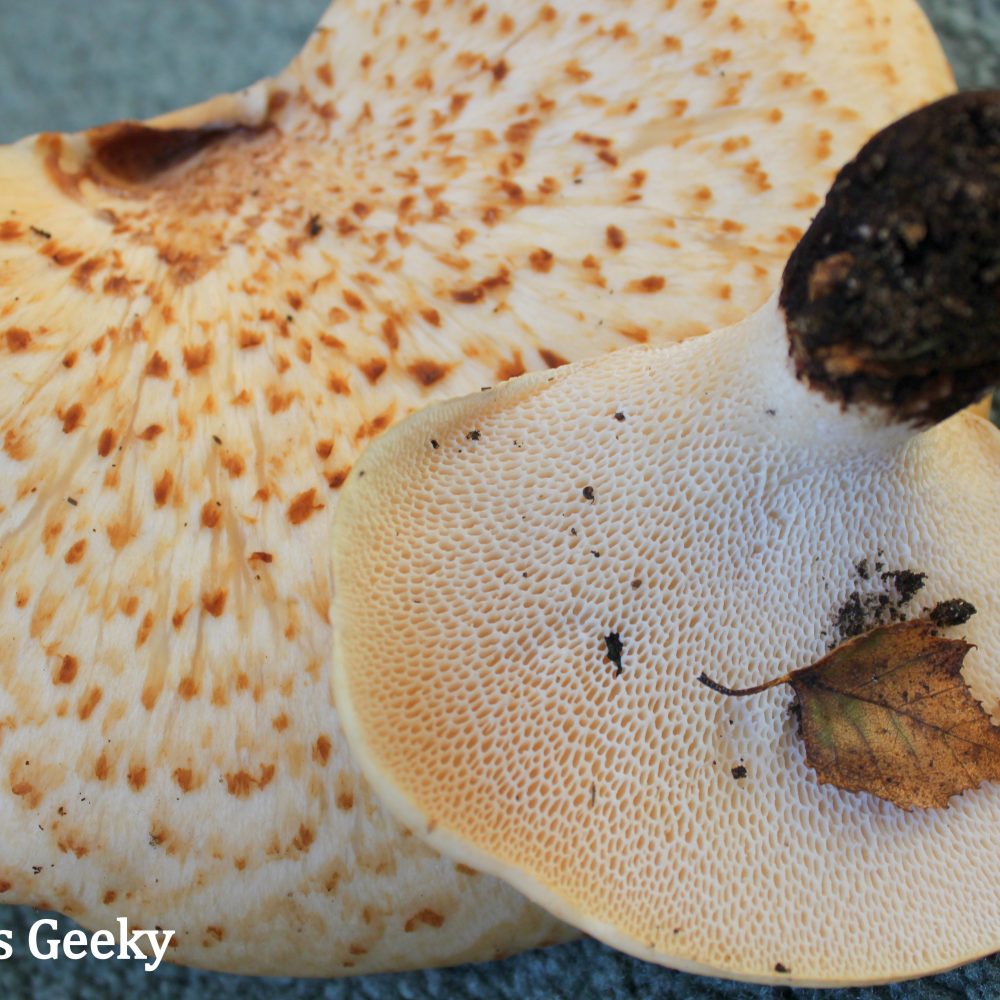
Spring and autumn are great times to hunt mushrooms. The only problem is that many mushrooms are poisonous. And to differ edible one from the one that will get you in a trouble can be not an easy task, especially for a beginner.
But that’s not the case with Dryad’s saddle, which is very easy to identify and whose lookalikes could be not edible (due to tough texture), but not poisonous. And because it grows on fallen trees, it’s very easy to spot. You’ve probably seen it before while walking in the park or even in your backyard (like I did just one week ago).
Hope you won’t miss it next time after reading this article.
Disclaimer: Don’t eat mushrooms, if you are not 100% sure. I don’t take responsibility for your ability to identify dryad’s saddle correctly.
Identification and Ecology
Dryad saddle is a species of bracket fungus, which usually grows on dead wood, and more rarely on living trees all over the world (North America, Australia, Asia, and Europe). Cap is fan-shaped up to 12 inches in diameter and up to 2 inches thick, white to beige in color with beige to brown scales, which makes it look like a pheasant’s back or hawk's wing. It has a short stem attached to the edge of a cap, rather than in the center.
There is another mushroom that is known under hawks' wing mushroom - Sarcodon imbricatus. But this fungus grows on the ground first, has a round cap, its stem is located in the center, and has teeth hemynophore instead of tubes.
The underneath side of the cap is all in pores or actually little tubes (you can see it clearly if you cut the cap). Spores are formed in these tubes. The flesh of mushrooms is white to off-white and doesn’t change color when exposed to air. It also has a distinct smell of watermelon rind or cucumber.
Fun fact: The name dryad’s saddle came from Greek mythology. Greeks believed that tiny tree nymphs – dryads, were riding on these mushrooms.
Dryad’s saddle toughens when gets older, so pick only young fruit bodies. You should easily slice it with your knife, or it means they’re too old to be eaten. This mushroom will reappear in the same place year after year until it consumes all wood it grows on.
Most often Polyporus squamosus can be found in May and June, the same time morels grow. But also can appear in autumn (September/October).
The other Latin names Dryad’s saddle could be called (as it’s always very complicated about fungal taxonomy) are Polyporus septosporus and Cerioporus squamosus.
Dryad’s saddle lookalikes
Let’s clarify that there are no poisonous bracket mushrooms, but very few of them are edible, dew to their very tough texture. So there is no dangerous look-alike for Polyporus squamsus. But an important thing to remember is that the Dryad saddle has pores (tubes) on the underneath side (hymenophore). If it has gills, like a portabella mushroom, it’s definitely better to stay away from it.
Dryad’s saddle medicinal properties
Many people are asking about the medicinal properties of this shelf mushroom, though they are yet to be discovered. There is no traditional medicinal use for Polyporus squamosus as for many other bracket mushrooms.
Dryad’s saddle cooking
You can cook Pheasantback mushrooms in any way you do other mushrooms. You can dry them, use them for stock or in the soup, deep fry or pan fry.
But my favorite (and very easy) way is to sauté them with onions and herbs in white wine and sprinkled with Parmesan before serving. If you want to check the complete recipe.
Dryad’s Saddle Parmesan Pinot Grigio Sauté Recipe

Dryad’s Saddle is an often overlooked mushroom, with a great taste, as to my pallets.
This mushroom is also known under the names pheasant back and hawk’s tail mushroom or the Latin name Polyporus squamosus.
But if you landed on this page after looking for dryad’s saddle recipe ideas, you won’t be disappointed with this particular recipe, as it’s very easy and ends up deliciously.
Ingredients list (serving 1 person):
- Dryad’s saddle mushroom – 4oz (120g)
- Onion – 1 medium
- Butter (or other oil) – 2 Tb. sp.
- Pinot Grigio wine (Chardonnay will work too) – 1/3 cup
- Salt and black pepper - to taste
- Grated Parmesan – 1 Tb. sp.
- Fresh rosemary (optional) – 1/3 of a stalk
Step-by-step instructions:
- Melt the butter in a frying pan
- Slice onions in half-rings
- Slice dryad’s saddle into thin strips. If the stem part is not slicing easily, get rid of it.
- Add mushrooms and onions to melted butter and pan-fry on medium-high heat for a couple of minutes, until golden.
- Add salt, pepper, and minced rosemary. Fry for another minute or two.
- Add wine and reduce heat to medium-low, sauté for another 3 to 5 minutes.
- Transfer to a serving plate and sprinkle with Parmesan.
You can serve Dryad’s saddle Parmesan Pinot Grigio sauté with white bread or over the rice, pasta, or mashed
potatoes.
Enjoy! And what is your favorite recipe with Dryad’s saddle mushroom?
I Hope, after reading my article, you won't miss this beautiful and delicious mushroom again.